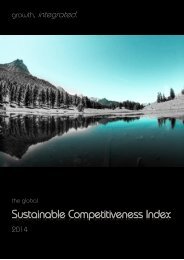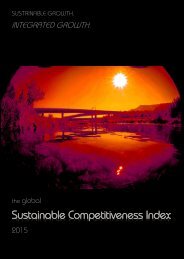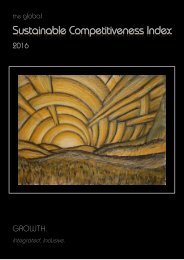Sustainable_Competitiveness_Index_2013
Create successful ePaper yourself
Turn your PDF publications into a flip-book with our unique Google optimized e-Paper software.
World Map<br />
Natural Capital<br />
Biodiversity, water and raw materials determine natural capital competitiveness<br />
The potential for sustaining natural capital as a basis for sustained competitiveness is composed of two main<br />
factors: the characteristics of geography and climate, combined with the extend of human activities that<br />
have or will affect the ability of natural factors to sustain the population and the economy.<br />
Because the natural capital is a given value – it is as it is – there are limitations to improve or change the<br />
available natural capital. While it takes little to impair or exploit the natural capital, rebuilding or improving<br />
natural capital factors is difficult, and requires significant time and resources.<br />
The natural capital sustainability map below indicates a certain correlation with the level of human activities<br />
and population density. Large countries with a comparably small population density and rich biodiversity<br />
are on top of the Natural Capital ranking (North America, Scandinavia, Brazil). A large number of countries<br />
located in tropical areas (at the intersection of Central and South America, West Africa, South-East Asia)<br />
also seem to have the potential to achieve sustainable development based on their respective natural<br />
capital. Both of these observations underline the overarching importance of the availability of water for<br />
humanity.<br />
The top ten according to natural capital indicators contains some surprising and not well known countries<br />
like Papua New Guinea, Suriname, Guyana, and Laos - whereas the OECD’s representation in the top<br />
twenty is limited to Canada, Ne Zealand, Denmark and Norway. The ranking of China (149) and India (126)<br />
are affected by a combination of arid climate, high population density, and depletion levels, raising some<br />
concerns to these countries ability to sustain their large populations.<br />
The Natural Capital World map: dark colour indicates high, light colour limited availability (or high depletion) of Natural Capital<br />
Page 16<br />
The <strong>Sustainable</strong> <strong>Competitiveness</strong> <strong>Index</strong> <strong>2013</strong><br />
Table of contents








